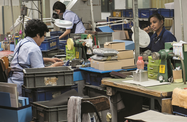A cooling domestic economy and uncertainty over the pace of global recovery could slow the rebound of Malaysia’s automotive sector, which has seen sales decline year-to-date.
However, government support for one of the leading local producers and the launch of new models could help reverse this downward trend.
Sales dip in 2016
There has been a marked slowdown in sales year-to-date, according to data from the Malaysia Automotive Association (MAA) released in June.
Sales through to May on a total industry volume level were down 18% year-on-year (y-o-y), with 218,101 units sold against 264,818 for the first five months of 2015. Compared to April sales, however, the industry registered a 6% month-on-month uptick.
The MAA, which represents producers in the industry, has forecast a full-year decline of 2.5%, with around 650,000 vehicles expected to be sold. Other projections put the dip somewhat steeper, with estimated sales of 626,600, a fall of 6% y-o-y.
Part of the double-digit year-to-date decline can be explained by elevated sales in early 2015, driven by consumers looking to make vehicle purchases ahead of the introduction of a 6% goods and services tax on April 1 of that year.
The industry will be looking for sales to rebound somewhat in the latter half of the year, with expectations pinned on the roll-out of new models by a number of manufacturers, and on the traditional seasonal spike in demand at the end of Ramadan.
Nonetheless, growing uncertainty over the health of the global economy, in part prompted by concerns over the UK’s decision to leave the EU, may curb buyer enthusiasm.
Underweight automotive
Despite the month-on-month increase in sales in May and expectations of improved results in the last two quarters, RAM Ratings Service has maintained its negative outlook for the automotive industry.
Consumer confidence was expected to remain weak this year, owing to the uncertain global economic environment, the rising cost of living and tighter credit conditions, according to a statement issued in late June by Kevin Lim, RAM’s head of consumer and industrial ratings.
“These challenges will pose a severe drag on automotive sales, although a slight uptick is anticipated in the second half, in view of the introduction of significant new models,” he said.
Impact on local players
One of the players hardest hit by the falls in sales is local producer Proton Holdings. The local company’s sales were down 27% year-on-year through to the end of April, with just 23,000 vehicles sold in the first four months of the year.
In early June the government stepped in to support the producer, announcing a soft loan of RM1.25bn ($305.5m) by subscribing to convertible debt to be issued by Proton. As part of the agreement, Proton issued RM1.25bn ($305.5m) worth of redeemable convertible cumulative preference shares, subscribed to by the state.
The funds are to be used to pay off short-term debts and provide the company with liquidity, according to a statement issued by Mustapa Mohamed, minister of international trade and industry, in early June.
In return for this support, Proton will need to strengthen its operational base by forming a partnership with another firm and develop a medium-term plan to turn its falling market position around.
One of Malaysia’s other top manufacturers, Peroduo, has also seen sales slip this year, though with 15,000 units sold in May, it has been able to maintain its market share of close to 35%.
With a new model sedan set to launch later this year, industry forecasts expect Peroduo will reach its 2016 sales target of 200,000 vehicles, just short of the 213,000 sold last year.
Gearing up
Manufacturers are looking to the medium term for a positive shift, with prospects expected to be stronger in 2017 and beyond on the back of more robust economic growth.
To take advantage of this expected increase in demand, in May Japanese producer Toyota announced plans to build a $489m car assembly plant at Klang in Selangor state.
The factory, set to come on-line in 2019, will have an annual production capacity of 50,000 units and is intended to take advantage of what Toyota said was the “gradual growth of the Malaysian market”. Work on the 670,000-sq-metre plant is due to begin in the second half of 2016.
The new plant is also part of a wider rationalisation of production, with Toyota to concentrate commercial vehicle production at its existing Malaysia facility at Shah Alam.
Between the two plants, Toyota will have a combined in-country production capacity of around 100,000 units per year and be well placed to take advantage of expected demand growth in the coming years.
Oxford Business Group is now on Instagram. Follow us here for news and stunning imagery from the more than 30 markets we cover.

